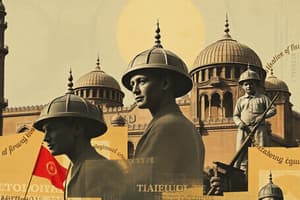Podcast
Questions and Answers
What happens to the surplus from the fund after all liabilities and direct expenses are met in a takaful contract?
What happens to the surplus from the fund after all liabilities and direct expenses are met in a takaful contract?
- It is reinvested into the fund for future expenses.
- It is retained solely by the operator.
- It is entirely distributed to participants.
- It is shared between participants and the operator as previously agreed. (correct)
In the Modified Mudharabah model, how are management expenses treated?
In the Modified Mudharabah model, how are management expenses treated?
- They are absorbed entirely by the Takaful Operator.
- They are not accounted for in the financial year.
- They are shared between participants and operators.
- They are charged to the Takaful fund. (correct)
What is the role of the Takaful Operator under the Wakalah model?
What is the role of the Takaful Operator under the Wakalah model?
- To directly invest participants' funds in equity markets.
- To solely retain all contributions from participants.
- To engage in profit-sharing schemes with other businesses.
- To act on behalf of participants for a fee. (correct)
What is a significant key factor for the success of the Wakalah-Waqf model?
What is a significant key factor for the success of the Wakalah-Waqf model?
Which statement correctly describes the fee structure in the Wakalah model?
Which statement correctly describes the fee structure in the Wakalah model?
Where is the Wakalah-Waqf model currently being adopted?
Where is the Wakalah-Waqf model currently being adopted?
In the context of the Mudharabah model, what is the implication of a surplus?
In the context of the Mudharabah model, what is the implication of a surplus?
How do participants contribute to the waqf fund in the Wakalah-Waqf model?
How do participants contribute to the waqf fund in the Wakalah-Waqf model?
What is the primary function of tabarru in the takaful system?
What is the primary function of tabarru in the takaful system?
Which of the following models is specifically practiced in the Middle East?
Which of the following models is specifically practiced in the Middle East?
Which of the following best describes the Mudharabah Model?
Which of the following best describes the Mudharabah Model?
What does gharar refer to in the context of the takaful business model?
What does gharar refer to in the context of the takaful business model?
How does the Wakalah-Waqf model differentiate itself from the other takaful models?
How does the Wakalah-Waqf model differentiate itself from the other takaful models?
Which of the following elements is NOT a characteristic of the takaful system?
Which of the following elements is NOT a characteristic of the takaful system?
What is one key factor that makes the uncertainty element allowable under the takaful contract?
What is one key factor that makes the uncertainty element allowable under the takaful contract?
Which aspect of risk management is emphasized in the takaful business model?
Which aspect of risk management is emphasized in the takaful business model?
Flashcards
Mudharabah Model
Mudharabah Model
A takaful model where the surplus generated after meeting liabilities and direct expenses is shared proportionally between the participant and the operator, as agreed upon at the start of the contract.
Modified Mudharabah Model
Modified Mudharabah Model
A takaful model where all management expenses (direct and indirect) are charged to the takaful fund.
Wakalah Model
Wakalah Model
A takaful model based on an agency relationship where the participant (principal) appoints the takaful operator (agent) to manage their participation in various takaful products.
Wakalah-Waqf Model
Wakalah-Waqf Model
Signup and view all the flashcards
Takaful
Takaful
Signup and view all the flashcards
Tabarru
Tabarru
Signup and view all the flashcards
Pure Mudharabah
Pure Mudharabah
Signup and view all the flashcards
Modified Mudharabah
Modified Mudharabah
Signup and view all the flashcards
Gharar
Gharar
Signup and view all the flashcards
Study Notes
Takaful Business Model
- Takaful is a cooperative insurance model originating in Sudan in 1979
- Three main models developed: Mudharabah, Wakalah, and Wakalah-Waqf
- These models differ in their approaches to risk sharing, expenses, and fund management
Types of Takaful Model
- Mudharabah Model (Malaysia, Brunei, Indonesia): Fund is managed based on a profit-sharing agreement. Expenses and investment returns are shared between the shareholders and the operator.
- Wakalah Model: The takaful participant appoints the operator as an agent. A management fee is charged for services.
- Wakalah-Waqf Model (Pakistan): Combines Wakalah with a waqf fund (endowment fund), a portion of participant contributions is set aside for beneficiaries.
Concept of Takaful
- Takaful: Arabic word meaning "joint guarantee." Participants collectively guarantee each other against agreed-upon losses.
- Tabarru': Donations or contributions to a shared fund. Participants give up a portion of their contributions to assist others facing difficulties.
- Core principle: Shared responsibility, joint indemnity, and mutual protection. It allows uncertainty to be managed within the takaful contract.
Main Elements
- All transactions compliant with Sharia law.
- Avoids riba (interest), and maisir (gambling).
- Cooperative risk-sharing
- Clear segregation of roles for parties.
- Tabarru' (donation) or waqf (endowment fund) used for risk sharing.
Mudharabah Model
- Mudharabah, also known as Rabbul Mal, is practiced in Malaysia, Brunei, and Indonesia.
- Exists in pure and modified forms
- Pure Mudharabah: All expenses (direct and indirect) are charged to the shareholders' pool. Profit and returns are shared at a pre-determined ratio.
- Modified Mudharabah: All management expenses are charged to the takaful fund, unlike the pure model, which keeps them separate.
Mudharabah Model - Family Takaful
- A system within the wide category of Mudharabah model.
- The company acts as the trustee. Investment and profits are shared at agreed upon ratios.
Wakalah Model
- Wakalah is an agency relationship where one party (Takaful operator) acts on behalf of another (participant).
- The takaful operator is paid a pre-determined management fee for their services including underwriting, management and investment of the fund.
- The fee is charged to participant contributions.
Wakalah Model- Family Takaful
- Companies offer various risk and investment type products. Balances are kept separate between respective accounts.
Wakalah-Waqf Model
- Wakalah-waqf is a variation of the Wakalah Model. It involves creating a waqf(endowement) fund which participants contribute to.
- The company may deduct a ceding amount to compensate beneficiaries.
- The waqf fund is separate from the general fund.
- Mostly adopted in Pakistan.
Studying That Suits You
Use AI to generate personalized quizzes and flashcards to suit your learning preferences.




